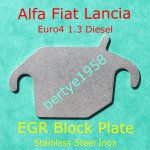hi
just bought a panda 1.3D 2005. i want to blanking the egr valve or completily eliminate it. i been looking online for a blanking plate but cant find one for the panda. please is there another way to disable it. also where is located. in the past i blanked a punto egr but i cant see it on the panda. is there a guide on the forum that i can use.
thanks
just bought a panda 1.3D 2005. i want to blanking the egr valve or completily eliminate it. i been looking online for a blanking plate but cant find one for the panda. please is there another way to disable it. also where is located. in the past i blanked a punto egr but i cant see it on the panda. is there a guide on the forum that i can use.
thanks




